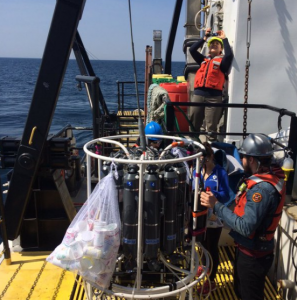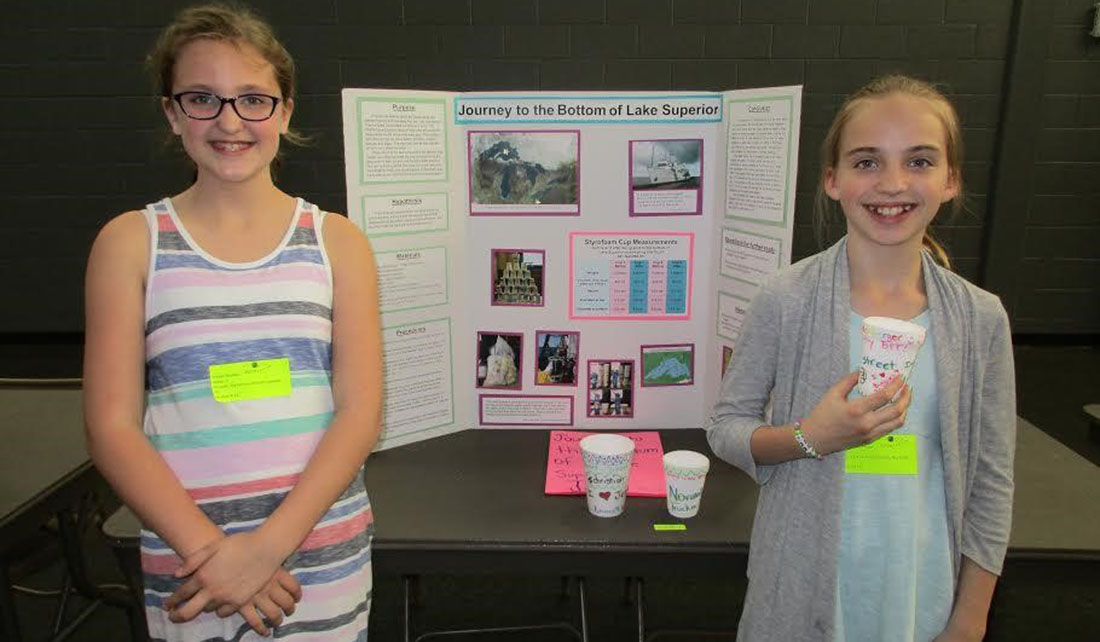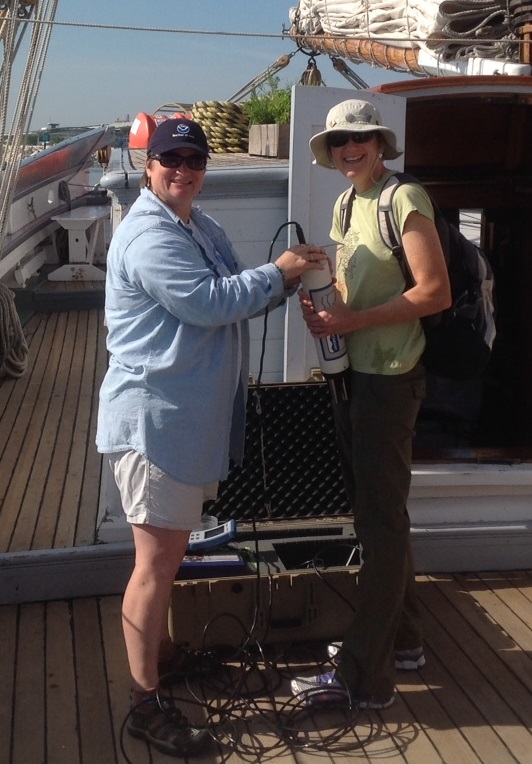June 24th, 2016 by IISG
U.S. EPA’s Research Vessel Lake Guardian graces our page once again for this year’s annual Shipboard Science Workshop. “This workshop allows educators to work on a research project with a Great Lakes scientist for the week they are on the ship,” said IISG Educator Allison Neubauer. “They use equipment to collect samples from the lake, analyze them in the labs onboard the ship, and come up with answers to the questions of their particular research project.”
Past workshops have included collecting data on plankton communities, plastic pollution, and overall water quality of the Great Lakes. This season, educators aboard the R/V Lake Guardian will have the opportunity to participate in what is known as The Incredible Shrinking Cup Lab, coordinated by Kristin TePas, IISG’s community outreach specialist.

The principle guiding The Incredible Shrinking Cup Lab is called Boyle’s law, which, when simplified, says that the volume of a gas is inversely proportional to the pressure being exerted upon it. We see this with weather balloons, which, when they’re launched, can range from 2.5 ft. to 8 ft. in diameter, but expand more than four times in diameter during flight, becoming as large as 32 ft. wide. As a balloon gains altitude, less pressure is being exerted on it from the outside, allowing the gas inside to expand until, ultimately, the balloon pops.
The Incredible Shrinking Cup Lab takes things in the opposite direction, observing the effects of increased pressure as Styrofoam cups are sunk hundreds of feet underneath the water. Gas pockets inside the Styrofoam cups shrink as the distance below sea level, and subsequent pressure, increases, compressing the cup’s structure, making it smaller.

Two students of Marcy Burns, Main Street Intermediate School in Norwalk, Ohio, pose after winning third place in the OhioView SATELLITES Conference and research project fair at the University of Toledo.
This activity provides students the opportunity to see the effects of Boyle’s law first hand. Before the cups are submerged, students are taught how to measure their volume, density, and mass. They personalize their cups to know whose is whose, craft hypotheses on what will happen to the cups, and are put into direct contact with research scientists, who do the submerging themselves once at their stations in the ocean or in the Great Lakes. Allison Neubauer was able to document two rounds of sending down cups this past April while aboard the R/V Lake Guardian in Lake Superior.
Illinois-Indiana Sea Grant is a part of University of Illinois Extension and Purdue Extension.
February 10th, 2015 by iisg_superadmin
A closer look at web tools and sites that boost research and empower Great Lakes communities to secure a healthy environment and economy.
Hundreds of invasive species are on the loose in U.S. waters wreaking havoc on habitats, recreation, and economies. Fortunately, a team of student detectives are on the case and ready to book these “bad guys” with help from Nab the Aquatic Invader!
 This educational website turns students grades 4-10 into PIs hot on the trail of some of the worst invaders in their region. After brushing up on detailed profiles complete with interrogation recordings, students take part in ongoing investigations led by veteran gumshoes. Whether they join as junior detectives or super sleuths, students learn to ID the suspects, expose the damage they cause, and stop invaders before they strike again.
This educational website turns students grades 4-10 into PIs hot on the trail of some of the worst invaders in their region. After brushing up on detailed profiles complete with interrogation recordings, students take part in ongoing investigations led by veteran gumshoes. Whether they join as junior detectives or super sleuths, students learn to ID the suspects, expose the damage they cause, and stop invaders before they strike again.
The site also includes a teacher Top Desk Administrator with example projects that give students a chance to share what they’ve learned with their communities. Along with detailed summary reports, these examples make it easy for teachers to plan and implement successful AIS stewardship projects in their own classroom.
But you don’t have to go online to crack a case. A suite of card games and posters inspired by the website are also available. Students and adults alike can even join the hunt for the most wanted AIS at the Smithsonian National Museum of Natural History in D.C. and at Coastal Ecosystem Learning Centers throughout the country.
Nab the Aquatic Invader! was created by IISG and Sea Grant programs in New York, Louisiana, Connecticut, and Oregon.
January 13th, 2015 by iisg_superadmin
Real-world, hands-on activities are bringing Great Lakes science alive for a group of Wisconsin middle school students. Our friends at Wisconsin Sea Grant have the story.
Two Wisconsin teachers have made exceptional use of the educational resources that Sea Grant has to offer. And not just resources from Wisconsin Sea Grant—the teachers have found valuable support from the Center for Great Lakes Literacy, a collaborative effort by educators in the Great Lakes Sea Grant Network funded through the Great Lakes Restoration Initiative.
The teachers are Lynn Kurth and Cindy Byers. Kurth works as a science teacher for Prairie River Middle School in Merrill, Wis. Just a 50-minute drive away, Byers works as a science and reading teacher for Rosholt Middle School in Rosholt, Wis.
They met in 2011 during a week-long voyage on the Lake Guardian, a research vessel owned by the U.S. Environmental Protection Agency (EPA). They were participating in a Shipboard and Shoreline Science Workshop, a program conducted by the Great Lakes Sea Grant programs through the former Centers for Ocean Sciences Education Excellence (which has become the Center for Great Lakes Literacy). They were part of a team of five colleagues who worked on a research project together. Kurth and Byers bonded over a Hydrolab—a large, tubular piece of water testing equipment—and it’s led to bigger and better things for both them, their students, and other teachers across the country.
The Hydrolab takes various water quality readings. Kurth and Byers were drawn to it because both of their schools are near rivers and the EPA was providing the device on loan for use with their classrooms after the cruise. They saw the opportunity to partner in the future.
It worked. “We supported each other’s teaching and enriched each other’s classrooms by having this collaboration,” Byers said. “We had the kids Skype with each other a couple of times and present the Hydrolab data they collected. Even though our schools are not that far apart, it seemed quite exotic to the kids and they were excited to use a piece of equipment that scientists use. A lot of the reasons we’ve been able to do so much with the program is that we’ve been supporting each other all along.”nce-in-a-lifetime learning experiences for students. In fact, 26 classes across the Great Lakes region took a break from their regular activities over the last year to video chat with the scientists behind the EPA Lake Guardian‘s annual monitoring cruises. Some students even took a guided virtual tour of the boat.
And now a new group of teachers and non-formal educators have an opportunity to work with Sea Grant specialists to introduce activities like these into their aquatic sciences sections during the 2015 Shipboard Science Workshop on Lake Michigan. Applications for the 15 available spaces are due February 10.
September 5th, 2013 by Irene Miles
The SeaPerch Program, sponsored by the Office of Naval Research, brings robotics and underwater science together to enhance classroom activities and curricula for a variety of grade levels. Illinois-Indiana Sea Grant recently sponsored a contestto give away several of the kits to teachers of grades 6-12, and the six winners will be receiving their new kits in the coming weeks. Blake Landry, project partner and coordinator of the University of Illinois’ SeaPerch Program, is working with IISG to provide continued support and training to the teachers and their students.
Teachers were asked to complete a survey and provide details about how they wanted to integrate the SeaPerch technology into their science lessons, and the responses were outstanding. In addition to bolstering their own classroom activities, several teachers hoped to use the starter kit and accompanying science lessons to share with teachers throughout the area. One winner wrote, “The SeaPerch program and applications would be an excellent topic to present at the Illinois Computing Educators Conference targeting science teachers and integration of science and engineering.”
In addition to offering a new tool to teachers, the contest helps to further activity and curriculum development and provides educators an opportunity to network and share their ideas with others. All of which complements IISG’s goal of fostering Great Lakes science literacy and engagement throughout the region.
July 16th, 2013 by Irene Miles
“Thank you for providing an awesome, informative, and very educational workshop,” said one teacher after last month’s B-WET field experience. “It was extremely helpful to me and, as a result, I feel very confident in addressing my students regarding the Great Lakes, knowing that now I have a plethora of resources, information, lessons, etc. at my disposal.”
All of the attendees at this year’s B-WET Field Experiences for Watershed Educators workshop shared similar positive feedback on the experience, and were genuinely excited at the opportunity to expand their science lessons. IISG’s education team led last month’s four-day training for teachers in Illinois and Indiana, where participants gained new hands-on skills and knowledge from invited speakers to take back to their classrooms.
 Teachers got to see a number of practices in action, including habitat restoration at Cowles Bog, a remediated and revitalized Roxana Marsh, water quality testing at the Peggy Notebaert Nature Museum pond, and more. They also got their hands dirty planting native species and performing a beach cleanup.
Teachers got to see a number of practices in action, including habitat restoration at Cowles Bog, a remediated and revitalized Roxana Marsh, water quality testing at the Peggy Notebaert Nature Museum pond, and more. They also got their hands dirty planting native species and performing a beach cleanup.
The workshop was designed explicitly to provide educators with a way to connect classroom concepts and scientific principles with real-world examples of watershed stewardship in action. Teachers engaged in fieldwork and collaborated with participating agency and organization educators who shared their program examples. As a result, teachers will be able to offer their students information that complements their science curricula. Additionally, the workshop gave them a chance to brainstorm new activities and lessons they could use with their students this fall.
Terri Hallesy, Illinois-Indiana Sea Grant education specialist explained, “As a result of this workshop, students will develop awareness and understanding about these critical environmental watershed issues based on the teachers’ new understandings. Educators will bring this increased confidence to their students to help excite them about engaging in Great Lakes stewardship.”
Added Rafael Rosa, Vice President of Education at the Peggy Notebaert Nature Museum, “What I was most impressed with was the enthusiasm of the teachers the program attracted. They asked great questions and more importantly were very open to sharing ideas and working with one another. I think I learned as much from them as they did from me.”
Funding was provided through a grant from the NOAA B-WET education program (linked above), and the workshop was made possible with assistance from Indiana Dunes State Park, the Great Lakes Research and Education Center at Indiana Dunes National Lakeshore, and the Alliance for the Great Lakes.
July 10th, 2013 by Irene Miles
From Robin Goettel, IISG associate director for education:
Scientists and teachers had a unique opportunity to interact, network, and connect research with education during The Center for Great Lakes Literacy’s Educator Day at last month’s IAGLR 2013 conference in West Lafayette, Indiana. Among the many goals of the IISG-coordinated session, providing opportunities for teachers to share their science education needs with researchers and identifying ways to incorporate the latest Great Lakes research into their lesson plans were high priorities.
The exchange of ideas was not only productive, but was a welcome and highly valued experience for all of the participants. The feedback received from both researchers and educators was outstanding, and offered a number of suggestions to guide another session like this in the future.
Said one teacher of the event, “I was impressed! My experience with IAGLR exceeded my expectations. I was hoping to simply gather more information to ‘grow’ my Great Lakes curriculum. However, I was able to network with other teachers and scientists which I found so much more valuable than walking away with a stack of Great Lakes lesson plans.”
Another educator was grateful for the opportunity to meet and talk to working researchers. “I am very thankful for the chance to interact with professionals in the field. Not only does attending scientific conferences refresh learned concepts, but allows for new learning, insight, and expansion of awareness. It also provided fresh ideas for project-based learning and the opportunity to network with potential collaborators.”
The participating scientists were also glad to brainstorm ways that their work could be incorporated into classroom lessons.
 “I always enjoy talking with teachers who are ‘in the trenches’ with younger students. They are faced with a different set of challenges (and opportunities) than we have at the college level. It was nice to hear that there are current efforts to better integrate math and science. It was also interesting to hear what teachers introduce in their classrooms to motivate and engage students in STEM areas.”
“I always enjoy talking with teachers who are ‘in the trenches’ with younger students. They are faced with a different set of challenges (and opportunities) than we have at the college level. It was nice to hear that there are current efforts to better integrate math and science. It was also interesting to hear what teachers introduce in their classrooms to motivate and engage students in STEM areas.”
May 28th, 2013 by Irene Miles
Dozens of Michigan teachers were some of the attendees at the 2013 Great Lakes Conference at Michigan State University back in March, and one of the most important topics of discussion was the current and future need for improving Great Lakes literacy.
From the MSU office of extension:
“At the luncheon, educators learned about upcoming professional development opportunities relating to the Great Lakes, and shared their best practices in Great Lakes education, as well as their priority needs relating to advancing Great Lakes literacy in the classroom.
So with the goal of advancing Great Lakes literacy in mind, what were some of their best practices and needs that emerged from the teacher discussion? The best practices clustered around five themes: 1) curriculum, 2) place-based education, 3) data in the classroom, 4) hands-on learning, and 5) cross-curriculum lessons…”
Follow the link above to read the complete article, including links to further information for educators.




.jpg)


